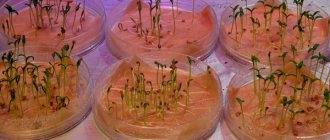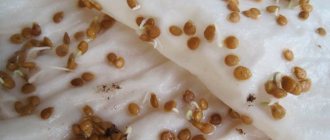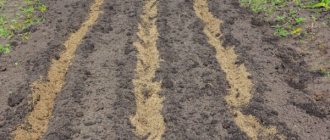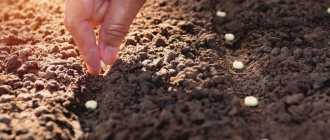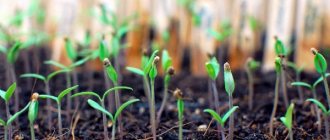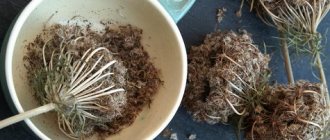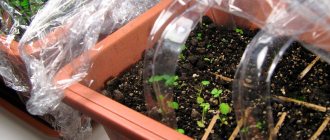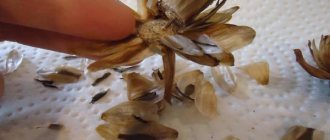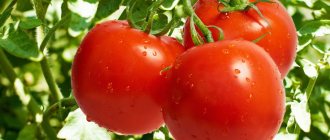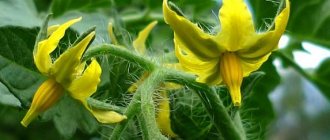Pre-sowing seed preparation includes a number of activities that have one goal - to ensure a good harvest. Here are its main types: sorting, disinfection, hardening, soaking and germination, vernalization, bubbling, treatment with microelements and growth stimulants, panning (when growing onions, sets are prepared). Pre-sowing preparation is useful in that it gives vegetable seeds resistance in difficult environmental conditions, enhances their sowing qualities, increases germination and significantly increases productivity. In our article we will talk about hardening seeds before planting seedlings.
What is seed hardening
This stage is required for heat-loving tomatoes, peppers, eggplants and melons. Seed hardening is carried out both at 0 and at minus 2-4 degrees. Swollen seeds that have gone through all other stages of preparation are exposed to stress temperatures. Hardening is not carried out if sprouts have already appeared, since a sharp drop in temperature can destroy them or stop growth.
Latest articles about gardening
What to do if tomato seedlings are stretched out and thin, so that they become strong and thick
All about animal mole rats: what do they eat, do they have eyes, what do they look like, babies, photos
Top 10 long-flowering perennials for the garden
Soaking seeds before planting
The process of soaking seeds
For rapid germination, the seed is soaked in melt or rain water at room temperature. The seeds are completely placed in water. The duration of such preparation depends on the type of crop:
- legumes – up to 7 hours;
- cabbage, tomatoes, cucumbers – 18 hours;
- onions, celery – 35 hours.
Every 3-4 hours it is advisable to change fresh water so that the seeds are well saturated with oxygen and do not spoil. After soaking, they need to be slightly dried or blotted with a napkin and immediately planted in the prepared soil.
Use of biostimulants
Soaking seeds with biostimulants before planting
For effective germination of embryos, biostimulants are added to the water - Epin (2-3 drops), Heteroauxin (1 tablet), sodium humate (one-third of a teaspoon per half liter). Instead of store-bought biostimulants, regular aloe juice is used.
Wood ash is used to enrich the seed with microelements. It is diluted with warm water (35 degrees), into which the seeds are placed for several hours. After this, they are dried or thoroughly blotted with a paper napkin.
What is vernalization of seeds
The vernalization method is a technology for preparing seeds of cold-resistant crops with long germination periods. Such cultures are typical specifically for Russian conditions. These are wheat, rye, oats and others, as well as traditional ones - onions, beets, parsley, carrots, cabbage, etc. Vernalization makes it possible to achieve plant resistance to transplants, cold, diseases, and other adverse effects, and also makes it possible to obtain high and earlier harvests due to shorter growing seasons.
It is important that in order to flower and bear fruit, some biennial and perennial crops must be subjected to cold treatment to initiate a natural physiological reaction in them.
At home, during vernalization, the seeds are first soaked, then germinated and then cooled in the refrigerator. During cooling, to avoid drying out, they are periodically sprayed with water. Some gardeners advise using snow water for soaking and cooling it by burying it in the snow, but this is just “dancing with a tambourine” which really only complicates the process without bringing any tangible benefit. You just need to use clean water.
Cooling and cold holding times depend on the variety and characteristics of the particular vegetable or grain crop, as well as the expected sowing time. So, for cabbage this is a temperature from 0 to +3 °C and a period of 10–15 days, for onions, carrots and parsley from -1 to +1 °C for 12–15 days. Increasing the cooling duration by 3–5 days is not critical for them. But for beets at the same temperature from -1 to +1 °C, the cooling duration should be no more than 8–10 days. Specific information on different plants and varieties can be found in reference books.
Why is cold a stimulus?
Natalya Filippova, AiF. At the dacha”: — Natalya Alexandrovna, where did this complex name “stratification” come from?
Natalya Slepchenko : - This is a Latin compound word consisting of two roots. The first part of the word stratum is translated as “layer”, and the second - facio - “I do”. Literally, the name means “to make a layer,” that is, to layer. The separation of the seed into layers is the beginning of the complex process of its awakening. In botany, stratification refers to storing plant seeds at a certain temperature (usually low positive) to accelerate germination. In other words, this is seed treatment by creating certain temperature conditions.
Article on the topic
Healthy offspring. Advice from an agronomist on seed procurement
— In nature, plant seeds are stratified naturally. After overwintering under the snow, they germinate safely in the spring. What crops can be subjected to such stratification?
— Natural stratification, according to many scientists, is the most optimal. For a number of ornamental crops that require long-term seed treatment, it is recommended to do it in the fall. These include: privet, Japanese quince, viburnum, rose hips, bird cherry, walnuts and Manchurian nuts, as well as mackerel and euonymus. But it is recommended to sow plants with very small seeds, such as mock orange, spirea, honeysuckle and others, in winter.
— Germination of dormant seeds of many species can last a long time (from several months to 1–2 years) after sowing. What factors determine sleep time?
— The seeds of many woody plants and wild species are characterized by deep dormancy. This process complicates both the cultivation of many ornamental plants in personal plots and the introduction of promising economically valuable plants into scientific institutions and botanical gardens. The depth of dormancy, its type, and the time to overcome depend on the geographical origin of the plants and differ among different species, even within the genus. It can be caused both by the retarding effect of the seed integument and by the state of the embryo. The dormancy period of seeds may also depend on the environmental conditions of their formation. There are physiological (low growth activity of the embryo and the retarding effect of the seed integument) and morphophysiological (underdevelopment of the embryo at the time of dissemination) types of dormancy.
Photo: Shutterstock.com
When to start hardening seeds and seedlings
It is impossible to clearly place dates on the calendar. Hardening of seeds is carried out in preparation for sowing, which means it depends on the timing of planting the crop. The procedure is carried out once during the day. This can be done directly during soaking by placing the seeds in the refrigerator, or immediately after the sprouts appear to stimulate germination.
After sowing, during the black earth period, the seeds are re-hardened, preferably in the open air. This is done to saturate the soil with oxygen and cleanse the soil of pests if it has been stored warm. Temperature changes also stimulate the onset of growth. Hardening of seedlings is carried out after the seedlings have strengthened, 2-3 days after their appearance. It is recommended to carry out this procedure before planting in the ground.
Hardening at home
Before the procedure, you need to thoroughly sort out the planting material and select large grains of the correct shape. Next, the seeds are soaked, disinfected and only then proceed to hardening.
To increase the germination of seeds, the container with dry seeds is placed in a plastic bag, which in turn is sent to the refrigerator for 12 hours - on the shelf where vegetables are stored.
In a refrigerator
This is one of the easiest ways to harden seeds before planting. Its essence is short-term treatment of seed material at low temperatures. Read about tall varieties of tomatoes for greenhouses in this article.
Procedure:
- Remove excess moisture from the swollen grains after soaking and place in the refrigerator at a temperature range of 0 to -3°C.
- Wait 20 hours, remove the seeds and place them in a room with a temperature of 20 degrees for 5-6 hours.
- Place in the refrigerator again.
- It is necessary to carry out such actions within 5-6 days.
Under natural conditions
The procedure is as follows:
- Wrap the already pre-soaked grains in cloth and leave for 12 hours at room temperature.
- Take the bag of seed outside and place it in the snow for 12 hours.
- It is recommended to carry out such alternation for 7-12 days, and then the material is completely ready for planting.
It is important that the snow temperature is not below -3°C, otherwise the seeds will die. You can control the temperature using a thermometer, lowering it into the snow from time to time. You can place grains in the snow during the day and bring them home at night. This material will tell you about growing onions.
The method of hardening in the refrigerator is considered safer for the seed, since it is easier to control the temperature.
How to harden seeds
If you decide to grow seedlings yourself and not buy them on the market, you need to start hardening from seeds. After this procedure, they will not be afraid of low temperatures. They are not afraid of drought and late blight. When to start seed hardening? What should you pay special attention to? These questions concern almost all gardeners. First, you need to place a small piece of cloth in a bowl and place the seeds on it. The size of the material should be such that the remaining part can cover the seeds. Water is poured into the bowl, the depth of which should not exceed one centimeter. To disinfect seeds, you can add a few drops of Fitosporin to the water. The flooded seeds should stand for one day at room temperature. Then the bowl is placed in the refrigerator. The water is not allowed to freeze completely; only a thin film of ice is allowed.
Latest articles about gardening
Pelargonium seeds planting and care
Fescue: planting and care in open ground
Autumn treatment of the garden with urea
Alternately kept in the cold and then in the heat. Then, they can be taken out of the water and planted. After this treatment of the seeds, plants grow on which the tomatoes begin to ripen much earlier. Plant productivity increases by almost 40%. A large number of tomatoes ripen directly on the root. The fact is that hardened seedlings begin to be planted a couple of weeks earlier than non-hardened ones. The flower cluster begins to form much earlier, and only after one leaf. In unhardened tomatoes, such formation of a flower cluster is possible only after the appearance of three leaves. After sowing hardened seeds, seedlings emerge on the second day, the leaves are directed upward.
Which tomato varieties should be hardened?
To increase the resistance of seeds to environmental conditions, any variety of tomatoes should be hardened, regardless of further growing conditions: in open ground or in a greenhouse.
However, early ripening varieties need hardening more than others :
- Sanka;
- Parodist;
- Marisha;
- Legionnaire F1;
- Maksimka;
- Cupid F1;
- Doll F1;
- Gina;
- Don Juan;
- Valentina;
- Benito F1;
- Explosion;
- Alpha;
- Aphrodite.
These varieties grow short (about 50-60 cm) and are suitable for growing in central Russia.
Express method of seed hardening
It is known that the best harvest comes from seeds several years after they are collected. But it is not always possible to accurately know their age. Seeds of unknown age or last year's are placed in fabric bags and placed on the battery. After three weeks, they will “age out,” meaning they will have the same characteristics as a two- or three-year-old. Fill them with hot water, the temperature of which is about 50 degrees, for two hours. Then they are placed in cold water for a couple of minutes and sent for germination.
Seedling care
When the seeds sprout, the boxes must be moved to a cool, well-lit room. During the first 3 weeks, seedlings develop slowly, and in the next 2-3 weeks they develop rapidly.
The first week in the room where the seedlings are located, the temperature should be about +17 degrees. After 3 days, for stronger seedlings, the air temperature is increased to 19 degrees during the day, and at night it is reduced to 15 degrees. This can be achieved by opening the window, but at the same time you need to protect the seedlings from wind and draft. This temperature should be maintained until 2-3 true leaves appear. This usually lasts a month.
During this time, the seedlings need to be watered 3 times and fed to get strong tomato seedlings.
Lack of light can cause seedlings to stretch
Containers with seedlings should be turned to the light on the other side every day to prevent them from stretching. To ensure air access to the roots of the seedlings, containers with seedlings on the windowsill are placed on stands.
How to grow cedar from seeds
- Hello! Please tell me how to grow cedars from nuts? Yazilya Yakupova. How to grow cedar from seeds Olga Ivanovna Medvedko, agronomist: - Growing cedars from seeds is a long process and is used extremely rarely in private gardening. But in general there are no difficulties in this. First of all, pay attention to the planting material. Seeds are important...
Thermal treatment of seeds
Heat treatment (warming in hot water) is done as follows: place the seeds in a gauze bag and lower it into a thermos for 20-30 minutes. And after this time, immediately place it under cold water for 2-3 minutes. Please note that deviations from this regime may have a detrimental effect on the quality of planting material!
Keep the seeds in a thermos for no more than 30 minutes
Seed heat treatment mode
| Culture | Temperature (°C) | Time (min) |
| Cabbage | 52-54 | 20 |
| Radish | 52-54 | 20 |
| Turnip | 52-54 | 20 |
| Swede | 52-54 | 20 |
| Tomato | 50-52 | 30 |
| Physalis | 50-52 | 30 |
| Eggplant | 50-52 | 25 |
| Beet | 48-50 | 25 |
During disinfection, about 30% of seeds may lose their viability. And this is normal: only non-viable specimens die during heat treatment.
How to grow raspberries from seeds
— I bought raspberry seeds, tell me: how to grow raspberries from seeds? Thank you in advance. Svetlana Timchenko. How to grow raspberries from seeds Olga Andreevna Gushchina, agronomist, gardener with extensive experience: - Growing raspberries from seeds is not difficult, but you need to be prepared for the fact that not all seeds will sprout in the first year of planting.…
